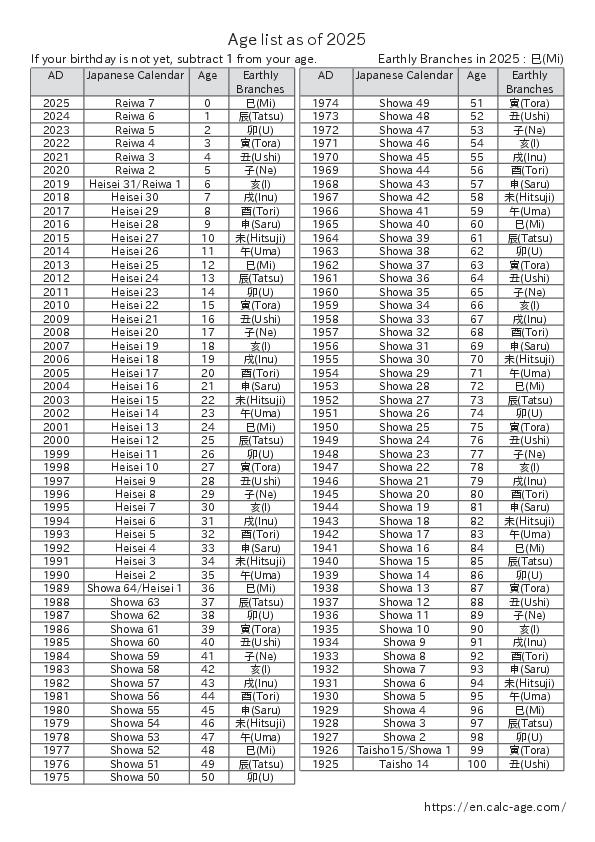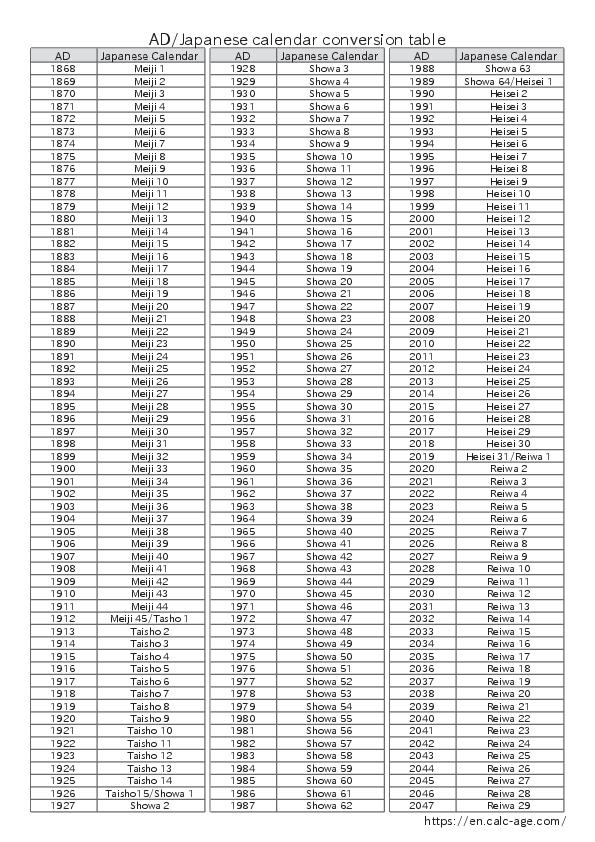Children's celebration list

This is a list of various celebration events since the birth of a child.
You can check the day of the celebration and what kind of celebration it is.
Click here if you want to calculate the date of the celebration from the date of birth
Children's celebration table
- ・Oshichiya(お七夜,N ame giving ceremony)
- ・Omiyamairi(お宮参り,Shrine visit)
- ・Hatsu-zekku(初節句,First festival)
- ・Okuizome(お食い初め,First meal)
- ・Half birthday
- ・Hatsu-shogatsu(初正月,First new year)
- ・Hatsu-tanjo(初誕生,First birth)
- ・Shichi-go-san(七五三)
- ・1/2 seijin-shiki(1/2成人式,1/2 coming-of-age ceremony)
- ・Jusan-mairi(十三詣り)
- ・Seijin'nohi(成人の日,Coming-of-age day)
Oshichiya(お七夜,N ame giving ceremony)
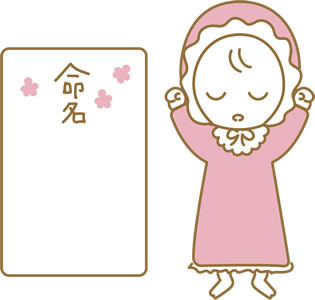
What is Oshichiya
"Oshichiya" is a celebration that takes place on the seventh night after a baby is born.
In the past, it was common for people to die right after giving birth, so I congratulate you for being able to make it to the 7th day without any problems.
Day to do Oshichiya
Oshichiya is the 7th night after birth, with the day you were born as the 1st day, so it will be 6 days after your birthday.
For example, if your birthday is the 3rd, it will be done on the 9th.
However, on the 7th day, there are cases where the mother and child are still in the hospital after giving birth, and both the mother and the child are not feeling well, so it may be performed on a different day.
What to do in Oshichiya
At Oshichiya, a "naming ceremony" will be held to announce the name of the newborn baby to family and relatives.
In the naming ceremony, write the name in the naming book and decorate it up to Omiyamairi.
I also have a meal with my family and people who have gathered together.
Red rice, red sea bream, kombu seaweed, clam soup, and other auspicious celebratory meals are common, but nowadays catering and delivery are becoming more common.
In addition, more and more people are taking handprints and footprints as souvenirs.
Omiyamairi(お宮参り,Shrine visit)

What is Omiyamairi
"Omiyamairi" is an event to report to Ubusunagami(産土神) that the baby is safely one month old and to pray for healthy growth in the future.
Also called "Hatsumiya-moude" or "Hatsumiya-mairi".
When to do Omiyamairi
Omiyamairi is generally performed on the 31st or 32nd day of life for boys and 32nd or 33rd day for girls, but there are differences depending on the region.
In addition, mothers and babies may not be feeling well because they are one month old, and depending on the time of year, it may be too hot or too cold.
Therefore, more and more people are shifting the date according to the physical condition of the mother and child, the climate, and the weather.
On this site, boys are calculated as 31 days old and girls as 32 days old.
What to do in Omiyamairi
Omiyamairi is generally a visit to the shrine in the area where the baby was born.
It is reported that a baby was born to the local deity of the land, and wishes for healthy growth in the future.
Recently, more and more people are visiting famous shrines outside their hometown, rather than local shrines.
Hatsu-zekku(初節句,First festival)

What is Hatsu-zekku
"Hatsu-zekku" is the first festival that a baby is born.
Boys are celebrated on May 5th on "Tango no Sekku", and girls on March 3rd on "Momo no Sekku".
When to do Hatsu-zekku
Generally, it is done when the baby is born and celebrates its first festival.
However, Hatsu-zekku may come before Omiyamairi depending on the day the baby was born.
In that case, Omiyamairi is often done first and then Hatsu-zekku the following year, so this site calculates for the next year.
What to do in Hatsu-zekku
For boys' festival, carp streamers, May dolls, helmets, etc. are displayed, and for girls' peach festival, hina dolls are displayed.
On the day of the festival, grandparents and relatives are invited to the house for a dinner party.
Okuizome(お食い初め,First meal)
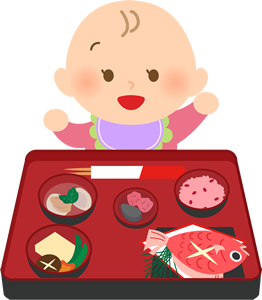
What is Okuizome(First meal)
"Okuizome(First meal)" is a celebration held on the 100th day after a baby is born.
Since baby teeth begin to grow around this time, it is an event to imitate eating with the wish that "there will be no trouble eating for the rest of your life."
It is also called “Momokaiwai(100th day celebration)” because it is held on the 100th day.
What to do in Okuizome(First meal)
At Okuizome(First meal), we will prepare a "Iwaizen(Celebration meal)" based on one soup and three side dishes.
Parents and grandparents of both families perform it, but when it is not convenient, it may be performed only by the family.
The oldest person of the same sex among them will imitate feeding as a "foster parent" because it will help them live a long life.
Half birthday
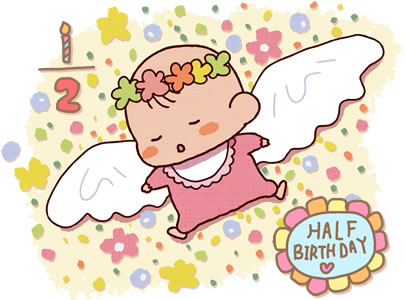
What is Half birthday
"Half birthday" is a celebration for six months after the birth of a baby.
Originally, it was a way of celebrating that spread in the United States and England, but it was a different way of celebrating in Japan.
In the U.S. and U.K., children who had birthdays during long vacations were sometimes not celebrated on their birthdays, so they celebrated six months before or six months after their birthday as Half birthday.
It became an event in Japan to celebrate a 6-month-old baby.
What to do in Half birthday
There are no special rules, but there are things like "sleeping art," where you can make art photos of your sleeping baby using props around him, or you can celebrate by making a baby food cake.
In addition, we will decorate the room with balloons, take the baby's handprints and footprints to commemorate, and take commemorative photos.
Hatsu-shogatsu(初正月,First new year)
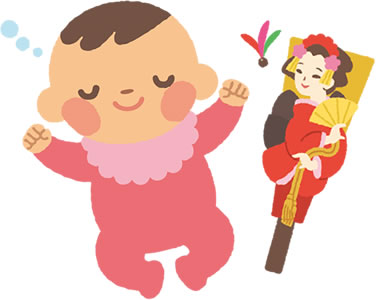
What is Hatsu-shogatsu
"Hatsu-shogatsu" is the first New Year for a baby.
Nowadays, it is common to count by Age, but Kazoedoshi was commonly used in the past.
In Kazoedoshi, babies are one year old when they are born, and they get one year older each New Year's Day, so Hatsu-shogatsu was their first birthday.
At that time, the living environment and medical technology were not in place, so I was grateful that I was able to grow up safely and celebrate my birthday.
What to do in Hatsu-shogatsu
At Hatsu-shogatsu, decorations are made to pray for the good health of babies and to ward off evil spirits.
For boys, "Hamaya" and "Hamayumi" are displayed, and for girls, "Hagoita" is displayed.
Hatsu-tanjo(初誕生,First birth)
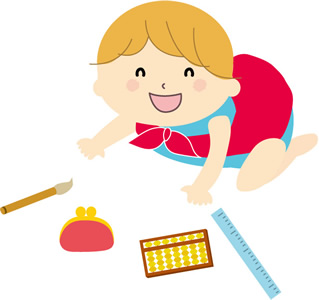
What is Hatsu-tanjo
"Hatsu-tanjo" is the baby's first birthday after being born.
In Japan, there used to be no custom to celebrate birthdays because they were counted by Kazoedoshi, but there was a custom to celebrate the 1st birthday in a big way.
We are grateful that we have lived and grown up safely for the first year since we were born, and we wish for good health in the future.
What to do in Hatsu-tanjo
In the old custom, there is a ritual called "Issho-mochi" in which mochi is wrapped in furoshiki and carried on the baby's back with the wish that the baby will not be in need of food.
In addition, there is a ritual called "Erabitori" in which various objects are placed a short distance in front of the baby, and the future is predicted by what to choose from among them.
Nowadays, there are many more informal celebrations, such as putting up a candle on a birthday cake.
Shichi-go-san(七五三)
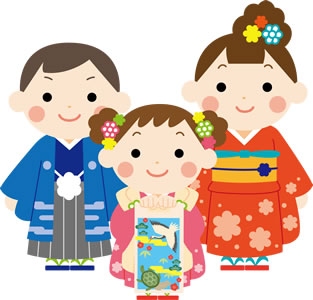
What is Shichi-go-san
"Shichi-go-san" is an event to appreciate and celebrate the growth of children aged 3, 5, and 7.
Boys are celebrated at ages 3 and 5, and girls at ages 3 and 7.
The age of the celebration is officially counted by Kazoedoshi, but recently it is often done by Age.
This site uses Kazoedoshi for each calculation.
What to do in Shichi-go-san
Shichi-go-san will visit the tutelary deity of the local shrine on November 15th to thank the children for their growth and pray for their healthy growth and happiness in the future.
Recently, it has become common to hold it on any Saturday, Sunday, or public holiday in November, instead of sticking to November 15th.
In addition, we may take a commemorative photo or invite grandparents to a dinner party.
1/2 seijin-shiki(1/2成人式,1/2 coming-of-age ceremony)

What is 1/2 seijin-shiki
"1/2 seijin-shiki" is an event to celebrate reaching the age of 10, which is half the age of 20.
It is also called "Jussai-shiki" or "half coming-of-age ceremony".
What to do in 1/2 seijin-shiki
School events include the announcement of letters of thanks from children to their parents, congratulatory speeches from the principal and representatives of parents, and the awarding of "half-adult certificates".
Also, recently, there are many commemorative photos taken at photo studios.
Jusan-mairi(十三詣り)
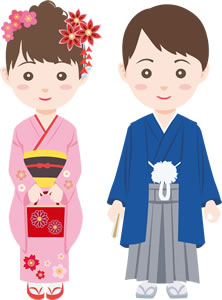
What is Jusan-mairi
"Jusan-mairi" is a prayer that a child who turned 13 at Kazoedoshi will be grateful for their growth so far, and will be blessed with wisdom and live a happy life. It is an event to visit the Kokuzo-bosatsu(虚空蔵菩薩).
The worship season is March 13th of the lunar calendar, which is now April 13th.
However, April 13th is right after the start of the new semester, so around March 13th to May 13th is the time to visit Jusan-mairi.
What to do in Jusan-mairi
At Jusan-mairi, boys wear haori and hakama, and girls wear furisode.
At that time, the girls wear the kimono for the first time, which is cut in the same way as the adults, using the same "Hondachi" style, with their shoulders raised.
Also, at Jusan-mairi, you write a single kanji character on a piece of paper with a brush, and offer it as a prayer.
Seijin'nohi(成人の日,Coming-of-age day)
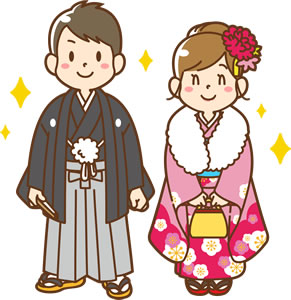
What is Seijin'nohi
"Seijin'nohi" is one of the national holidays with the purpose of "celebrating young people who realize that they have become adults and try to survive on their own."
Coming-of-age ceremonies are held in each municipality, inviting new adults.
Originally, January 15th was Seijin'nohi, but since 2000, it has been changed to the second Saturday of January with the introduction of the Happy Monday system.
What to do at Seijin'nohi
On Seijin'nohi, many municipalities hold coming-of-age ceremonies.
It is held to celebrate the new adults who will be responsible for the next generation and to promote awareness of the responsibility and obligations of joining the adult society.
Some local governments hold lectures and give commemorative gifts.
